Assessing Soil Key Fertility Attributes Using a Portable X-ray Fluorescence: A Simple Method to Overcome Matrix Effect
Abstract
:1. Introduction
2. Materials and Methods
2.1. Soil Samples
2.2. Reference Analyses
2.3. XRF Measurements
2.4. XRF Data Preprocessing and Related Analyses
2.5. Modeling
3. Results
3.1. Laboratory Measured Soil Properties
3.2. Effect of Compton Normalization on XRF Data
3.3. Matrix Effect Mitigation
3.3.1. Attenuation Promoted by Compton Normalization and MLR
3.3.2. Comparison Between MLR, PLSR, and the Geo Exploration Package
4. Discussion
5. Conclusions
Author Contributions
Funding
Acknowledgments
Conflicts of Interest
Appendix A
| Al-Kα | Si-Kα | K-Kα | Ca-Kα | Ti-Kα | Mn-Kα | Fe-Kα | Ni-Kα | Cu-Kα | Rh-Lα 3 | Rh-Kα 3 | Rh-Kα 4 | ||
|---|---|---|---|---|---|---|---|---|---|---|---|---|---|
| Clay | EL | −1.1 | −2.4 | −1.3 | −0.4 | −2.8 | −0.5 | 5.2 | −1.1 | −1.2 | −1.2 | 0.1 | −0.8 |
| ELC | −0.6 | −4.3 | −1.1 | −0.4 | −2.5 | −0.1 | 3.1 | −1.2 | −1.7 | −1.7 | 1.1 | −2.5 | |
| CEC 1 | EL | −0.5 | −0.4 | 1.5 | 4.6 | 2.5 | −1.6 | −0.4 | 1.3 | 0.8 | −0.8 | 0.0 | −0.2 |
| ELC | −0.3 | −0.5 | 1.4 | 5.9 | 3.3 | −1.2 | 0.8 | 0.9 | 0.9 | −0.2 | −0.7 | 1.8 | |
| ex-K 2 | EL | −1.0 | −1.0 | 19.0 | −5.8 | −0.8 | −2.1 | −1.4 | −0.5 | −0.6 | −4.4 | −1.2 | −2.5 |
| ELC | −0.8 | −0.6 | 22.0 | −5.4 | −0.1 | −2.3 | −0.8 | 0.8 | −0.5 | −4.0 | −0.9 | −1.9 | |
| ex-Ca 2 | EL | −1.1 | 0.8 | 1.0 | 9.2 | −0.2 | −1.8 | 0.5 | 1.1 | 0.6 | 0.8 | 1.5 | −1.3 |
| ELC | −1.3 | 0.6 | 1.0 | 11.9 | −0.4 | −1.0 | 0.9 | 0.7 | 0.5 | 1.3 | 1.5 | 0.1 | |
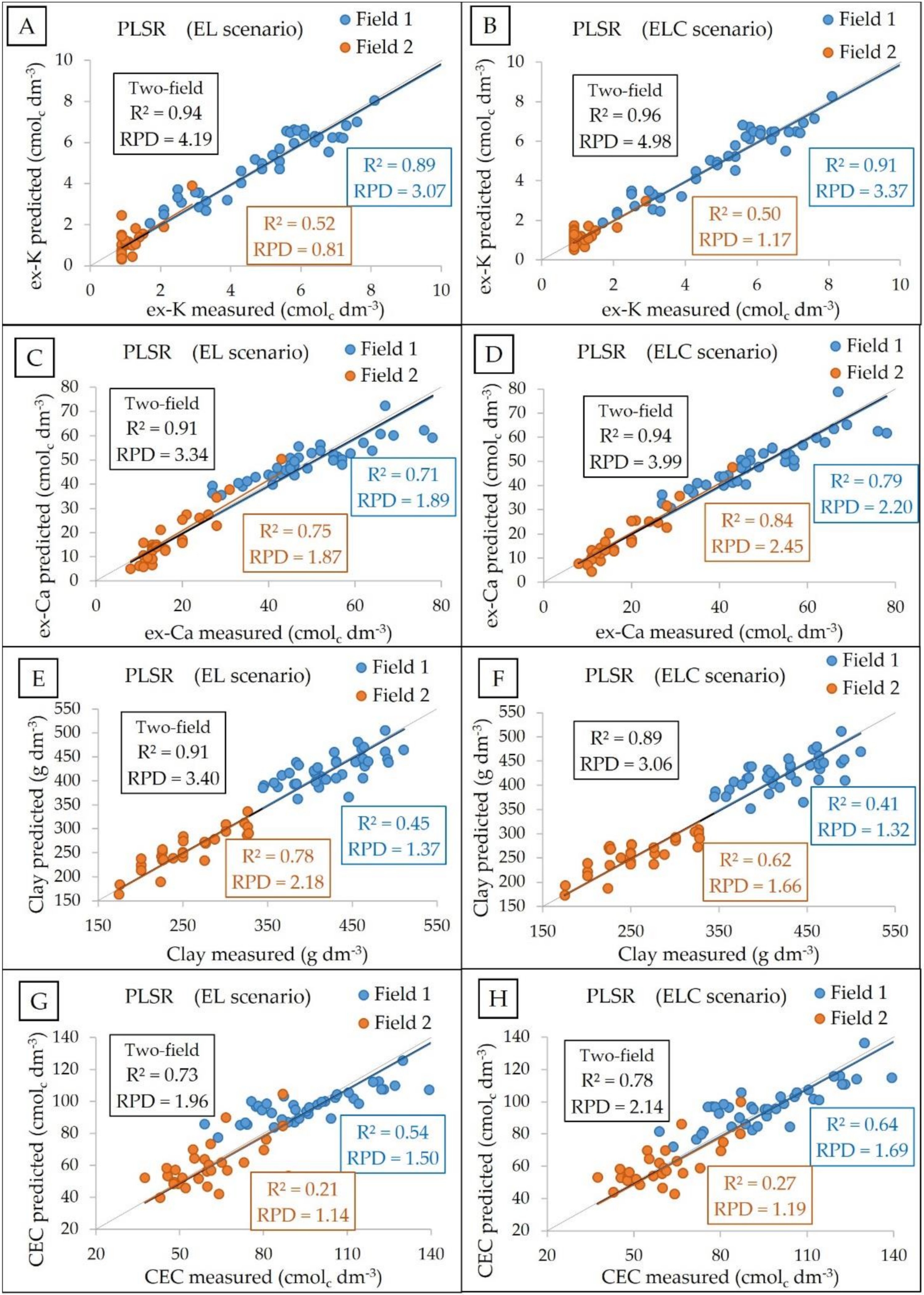
References
- Gebbers, R.; Adamchuk, V.I. Precision agriculture and food security. Science 2010, 327, 828–831. [Google Scholar] [CrossRef] [PubMed]
- Schirrmann, M.; Domsch, H. Sampling procedure simulating on-the-go sensing for soil nutrients. J. Soil Sci. Plant Nutr. 2011, 174, 333–343. [Google Scholar] [CrossRef]
- Molin, J.P.; Tavares, T.R. Sensor systems for mapping soil fertility attributes: Challenges, advances and perspectives in Brazilian tropical soils. Eng. Agric. 2019, 39, 126–147. [Google Scholar] [CrossRef] [Green Version]
- Rossel, R.A.V.; Adamchuk, V.I.; Sudduth, K.A.; Kenzie, N.J.M.; Lobsey, C. Proximal soil sensing: An effective approach for soil measurements in space and time. Adv. Agron. 2011, 113, 237–282. [Google Scholar] [CrossRef]
- Kuang, B.; Mahmood, H.S.; Quraishi, M.Z.; Hoogmoed, W.B.; Mouazen, A.M.; van Henten, E.J. Sensing soil properties in the laboratory, in situ, and on-line: A review. Adv. Agron. 2012, 114, 155–223. [Google Scholar] [CrossRef]
- Rossel, R.A.V.; Bouma, J. Soil sensing: A new paradigm for agriculture. Agric. Syst. 2016, 148, 71–74. [Google Scholar] [CrossRef]
- Mouazen, A.M.; Kuang, B. On-line visible and near infrared spectroscopy for in-field phosphorous Management. Soil Tillage Res. 2016, 155, 471–477. [Google Scholar] [CrossRef]
- Nawar, S.; Delbecque, N.; Declercq, Y.; Smedt, P.; Finke, P.; Verdoodt, A.; Meirvenne, M.V.; Mouazen, A.M. Can spectral analyses improve measurement of key soil fertility parameters with X-ray fluorescence spectrometry? Geoderma 2019, 350, 29–39. [Google Scholar] [CrossRef]
- Santos, F.R.; Oliveira, J.F.; Bona, E.; Santos, J.V.F.; Barboza, G.M.; Melquiades, F.L. EDXRF spectral data combined with PLSR to determine some soil fertility indicators. Microchem. J. 2020, 152, 104275. [Google Scholar] [CrossRef]
- Tavares, T.R.; Nunes, L.C.; Alves, E.E.N.; Almeida, E.; Maldaner, L.F.; Krug, F.J.; Carvalho, H.W.P.; Molin, J.P. Simplifying sample preparation for soil fertility analysis by X-ray fluorescence spectrometry. Sensors 2019, 19, 5066. [Google Scholar] [CrossRef] [Green Version]
- Gałuszka, A.; Migaszewski, Z.M.; Namieśnik, J. Moving your laboratories to the field—Advantages and limitations of the use of field portable instruments in environmental sample analysis. Environ. Res. 2015, 140, 593–603. [Google Scholar] [CrossRef] [PubMed]
- Morona, F.; Santos, F.R.; Brinatti, A.M.; Melquiades, F.L. Quick analysis of organic matter in soil by energy-dispersive X-ray fluorescence and multivariate analysis. Appl. Radiat. Isot. 2017, 130, 13–20. [Google Scholar] [CrossRef] [PubMed]
- Sharma, A.; Weindorf, D.C.; Man, T.; Aldabaa, A.A.A.; Chakraborty, S. Characterizing soils via portable X-ray fluorescence spectrometer: 3, Soil reaction (pH). Geoderma 2014, 232, 141–147. [Google Scholar] [CrossRef]
- Sharma, A.; Weindorf, D.C.; Wang, D.; Chakraborty, S. Characterizing soils via portable X-ray fluorescence spectrometer: 4, Cation exchange capacity (CEC). Geoderma 2015, 239, 130–134. [Google Scholar] [CrossRef]
- Rawal, A.; Chakraborty, S.; Li, B.; Lewis, K.; Godoy, M.; Paulette, L.; Weindorf, D.C. Determination of base saturation percentage in agricultural soils via portable X-ray fluorescence spectrometer. Geoderma 2019, 338, 375–382. [Google Scholar] [CrossRef]
- Silva, S.H.G.; Teixeira, A.F.D.S.; Menezes, M.D.D.; Guilherme, L.R.G.; Moreira, F.M.D.S.; Curi, N. Multiple linear regression and random forest to predict and map soil properties using data from portable X-ray fluorescence spectrometer (pXRF). Ciênc. Agrotecnol. 2017, 41, 648–664. [Google Scholar] [CrossRef]
- Teixeira, A.F.D.S.; Weindorf, D.C.; Silva, S.H.G.; Guilherme, L.R.G.; Curi, N. Portable X-ray fluorescence (pXRF) spectrometry applied to the prediction of chemical attributes in Inceptisols under different land uses. Ciênc. Agrotecnol. 2018, 42, 501–512. [Google Scholar] [CrossRef]
- Andrade, R.; Faria, W.M.; Silva, S.H.G.; Chakraborty, S.; Weindorf, D.C.; Mesquita, L.F.; Guilherme, L.R.G.; Curi, N. Prediction of soil fertility via portable X-ray fluorescence (pXRF) spectrometry and soil texture in the Brazilian Coastal Plains. Geoderma 2020, 357, 113960. [Google Scholar] [CrossRef]
- Zhu, Y.; Weindorf, D.C.; Zhang, W. Characterizing soils using a portable X-ray fluorescence spectrometer: 1. Soil texture. Geoderma 2011, 167, 167–177. [Google Scholar] [CrossRef]
- Silva, S.; Poggere, G.; Menezes, M.; Carvalho, G.; Guilherme, L.; Curi, N. Proximal sensing and digital terrain models applied to digital soil mapping and modeling of Brazilian Latosols (Oxisols). Remote Sens. 2016, 8, 614. [Google Scholar] [CrossRef] [Green Version]
- Lima, T.M.; Weindorf, D.C.; Curi, N.; Guilherme, L.R.; Lana, R.M.; Ribeiro, B.T. Elemental analysis of Cerrado agricultural soils via portable X-ray fluorescence spectrometry: Inferences for soil fertility assessment. Geoderma 2019, 353, 264–272. [Google Scholar] [CrossRef]
- Tavares, T.R.; Molin, J.P.; Nunes, L.C.; Alves, E.E.N.; Melquiades, F.L.; Carvalho, H.W.P.; Mouazen, A.M. Effect of X-ray tube configuration on measurement of key soil fertility attributes with XRF. Remote Sens. 2020, 12, 963. [Google Scholar] [CrossRef] [Green Version]
- Weindorf, D.C.; Zhu, Y.; Daniel, P.M.; Valerio, M.; Lynn, L.; Michaelson, G.; Clark, M.; Ping, C.L. Characterizing soils via portable X-ray fluorescence spectrometer: 2. Spodic and Albic horizons. Geoderma 2012, 189, 268–277. [Google Scholar] [CrossRef]
- O’Rourke, S.M.; Stockmann, U.; Holden, N.M.; Bratney, A.B.M.; Minasny, B. An assessment of model averaging to improve predictive power of portable vis-NIR and XRF for the determination of agronomic soil properties. Geoderma 2016, 279, 31–44. [Google Scholar] [CrossRef]
- Silva, E.A.; Weindorf, D.C.; Silva, S.H.; Ribeiro, B.T.; Poggere, G.C.; Carvalho, T.S.; Goncalves, M.G.; Guilherme, L.R.; Curi, N. Advances in Tropical Soil Characterization via Portable X-Ray Fluorescence Spectrometry. Pedosphere 2019, 29, 468–482. [Google Scholar] [CrossRef]
- Bowers, C. Matrix Effect Corrections in X-ray Fluorescence Spectrometry. J. Chem. Educ. 2019, 96, 2597–2599. [Google Scholar] [CrossRef]
- Weindorf, D.C.; Chakraborty, S. Portable X-ray fluorescence spectrometry analysis of soils. In Methods of Soil Analysis; Hirmas, D., Madison, W.I., Eds.; Soil Science Society of America: Wisconsin, WI, USA, 2016; pp. 1–8. [Google Scholar] [CrossRef]
- USEPA—United States Environmental Protection Agency (2007) Method 6200: Field portable X-ray Fluorescence Spectrometry for the Determination of Elemental Concentrations in Soil and Sediment. Available online: https://www.epa.gov/sites/production/files/2015-12/documents/6200.pdf (accessed on 25 March 2020).
- Kalnicky, D.J.; Singhvi, R. Field portable XRF analysis of environmental samples. J. Hazard. Mater. 2001, 83, 93–122. [Google Scholar] [CrossRef] [Green Version]
- Yılmaz, D.; Boydaş, E. The use of scattering peaks for matrix effect correction in WDXRF analysis. Radiat. Phys. Chem. 2018, 153, 17–20. [Google Scholar] [CrossRef]
- Panchuk, V.; Yaroshenko, I.; Legin, A.; Semenov, V.; Kirsanov, D. Application of chemometric methods to XRF-data—A tutorial review. Anal. Chim. Acta 2018, 1040, 19–32. [Google Scholar] [CrossRef]
- IUSS Working Group WRB. World reference base for soil resources 2014. In World Soil Resources Reports No. 106; Schad, P., van Huyssteen, C., Micheli, E., Eds.; FAO: Rome, Italy, 2014; p. 189. ISBN 978-92-5-108369-7. [Google Scholar]
- Van Raij, B.; Andrade, J.C.; Cantarela, H.; Quaggio, J.A. Análise Química Para Avaliação de Solos Tropicais; IAC: Campinas, Brazil, 2001; p. 285. (In Portuguese) [Google Scholar]
- Element, C.A.S. Method 3051A microwave assisted acid digestion of sediments, sludges, soils, and oils. Z. Für Anal. Chem. 2007, 111, 362–366. [Google Scholar]
- Mantler, M.; Willis, J.P.; Lachance, G.R.; Vrebos, B.A.R.; Mauser, K.E.; Kawahara, N.; Rousseau, R.M.; Brouwer, P.N. Quantitative analysis. In Handbook of Practical X-Ray Fluorescence Analysis; Burkhard, B., Kanngiesser, B., Langhoff, N., Wedell, R., Wolff, H., Eds.; Springer: Berlin/Heidelberg, Germany, 2006; pp. 309–410. [Google Scholar]
- Currie, L.A. Limits for qualitative detection and quantitative determination. Application to radiochemistry. Anal. Chem. 1968, 40, 586–593. [Google Scholar] [CrossRef]
- Nogueirol, R.C.; De Melo, W.J.; Bertoncini, E.I.; Alleoni, L.R.F. Concentrations of Cu, Fe, Mn, and Zn in tropical soils amended with sewage sludge and composted sewage sludge. Environ. Monit. Assess. 2013, 185, 2929–2938. [Google Scholar] [CrossRef]
- Silva, Y.J.A.B.; Nascimento, C.W.A.; Biondi, C.M. Comparison of USEPA digestion methods to heavy metals in soil samples. Environ. Monit. Assess. 2014, 186, 47–53. [Google Scholar] [CrossRef]
- Kennard, R.W.; Stone, L.A. Computer aided design of experiments. Technometrics 1969, 11, 137–148. [Google Scholar] [CrossRef]
- Chang, C.W.; Laird, D.A.; Mausbach, M.J.; Hurburgh, C.R. Near-infrared reflectance spectroscopy-principal components regression analyses of soil properties. Soil Sci. Soc. Am. J. 2001, 65, 480–490. [Google Scholar] [CrossRef] [Green Version]
- Van Raij, B. Fertilidade Do Solo e Manejo de Nutrientes; International Plant Nutrition Institute (IPNI): Piracicaba, São Paulo, Brazil, 2011; p. 420. (In Portuguese) [Google Scholar]
- Jenkins, R. X-Ray Fluorescence Spectrometry; John Wiley & Sons: Hoboken, NJ, USA, 2012; p. 232. [Google Scholar]
- Taggart, J.E., Jr.; Lindsay, J.R.; Scott, B.A.; Vivit, D.V.; Bartel, A.J.; Stewart, K.C. Analysis of geologic materials by wavelength-dispersive X-ray fluorescence spectrometry. In Methods for Geochemical Analysis; US Geological Survey Bulletin: Denver, CO, USA, 1987; Volume 1770, pp. 1–19. [Google Scholar]
- Gallhofer, D.; Lottermoser, B.G. The influence of spectral interferences on critical element determination with portable X-ray fluorescence (pXRF). Minerals 2018, 8, 320. [Google Scholar] [CrossRef] [Green Version]
- Markowicz, A.A. Chapter 2 quantification and correction procedures. In Portable X-ray Fluorescence Spectrometry: Capabilities for In Situ Analysis; The Royal Society of Chemistry: London, UK, 2008; pp. 13–38. [Google Scholar]
- Kaniu, M.I.; Angeyo, K.H.; Mangala, M.J.; Mwala, A.K.; Bartilol, S.K. Feasibility for chemometric energy dispersive X-ray fluorescence and scattering (EDXRFS) spectroscopy method for rapid soil quality assessment. X-Ray Spectrom. 2011, 40, 432–440. [Google Scholar] [CrossRef]
- Koch, J.; Chakraborty, S.; Li, B.; Kucera, J.M.; Van Deventer, P.; Daniell, A.; Faul, C.; Man, T.; Pearson, D.; Duda, B.; et al. Proximal sensor analysis of mine tailings in South Africa: An exploratory study. J. Geochem. Explor. 2017, 181, 45–57. [Google Scholar] [CrossRef]
- Chakraborty, S.; Li, B.; Weindorf, D.C.; Deb, S.; Acree, A.; De, P.; Panda, P. Use of portable X-ray fluorescence spectrometry for classifying soils from different land use land cover systems in India. Geoderma 2019, 338, 5–13. [Google Scholar] [CrossRef]
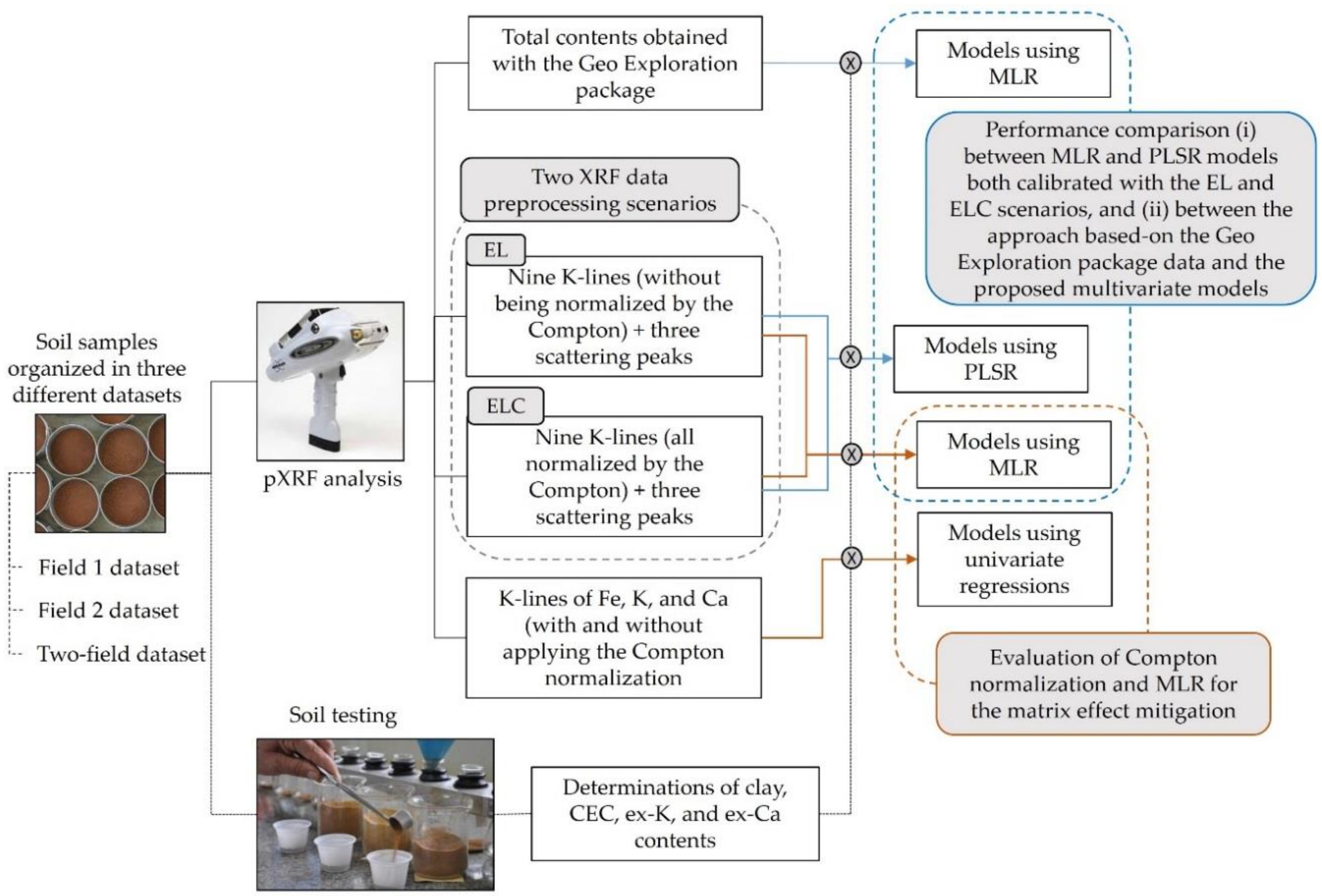
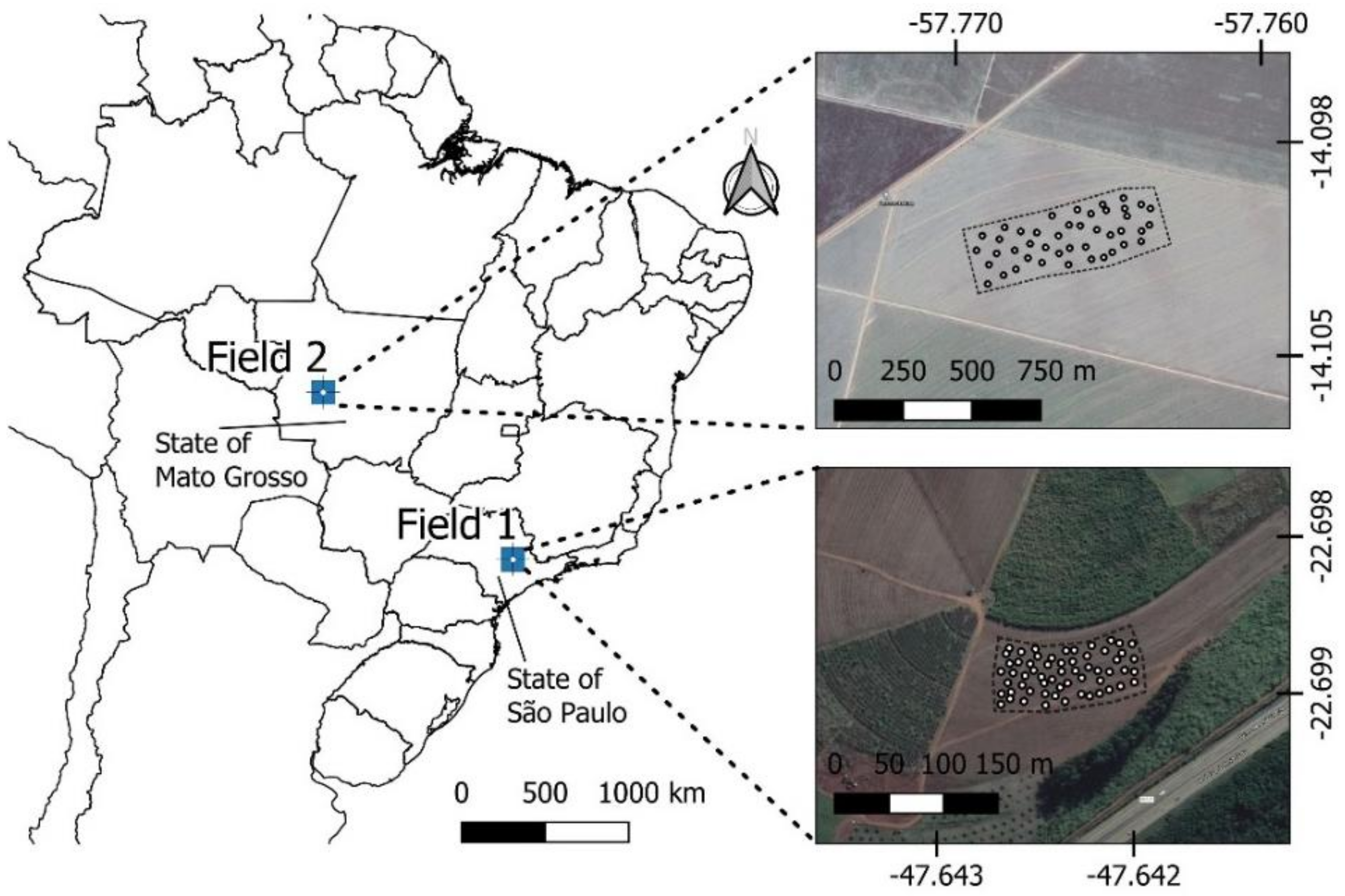
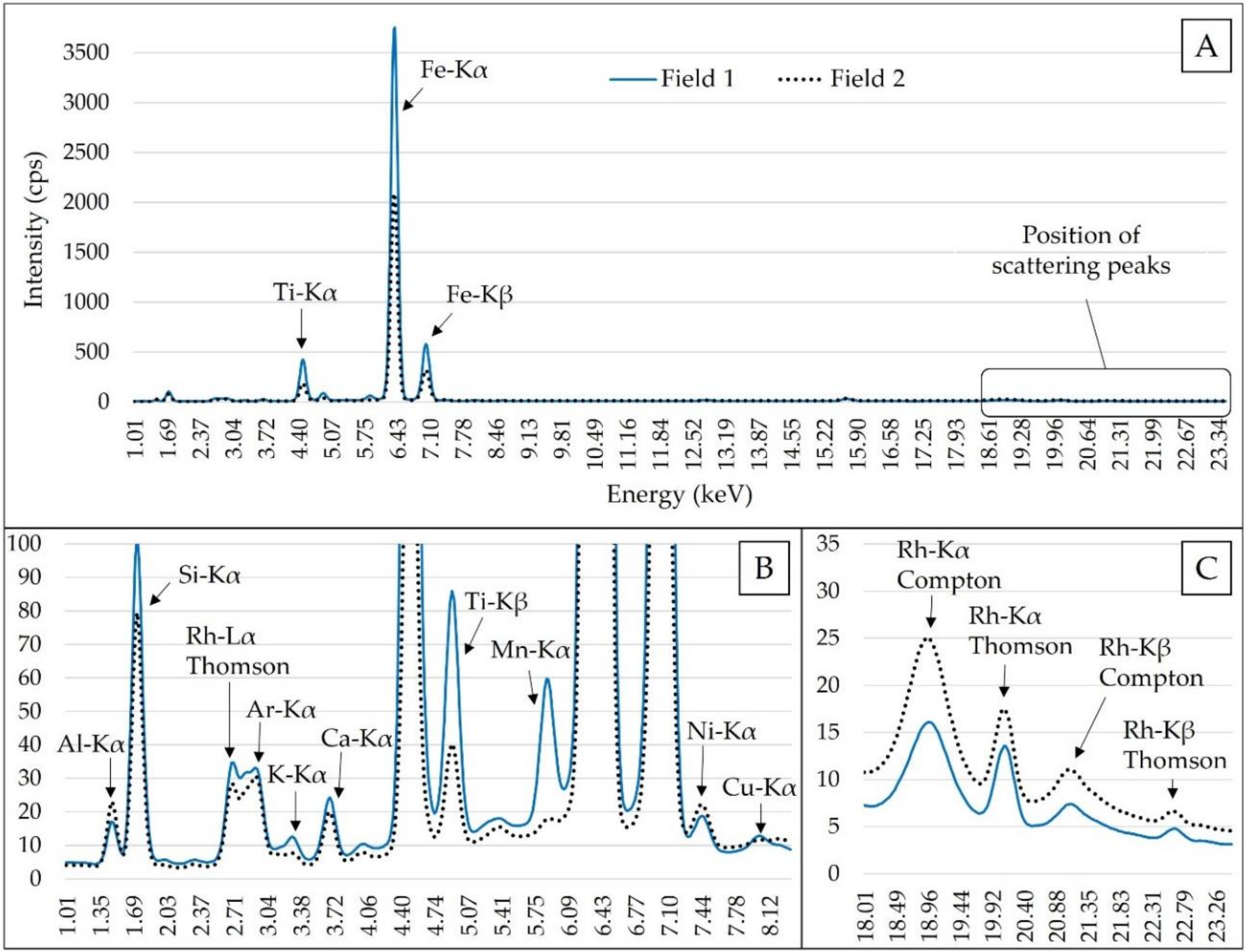
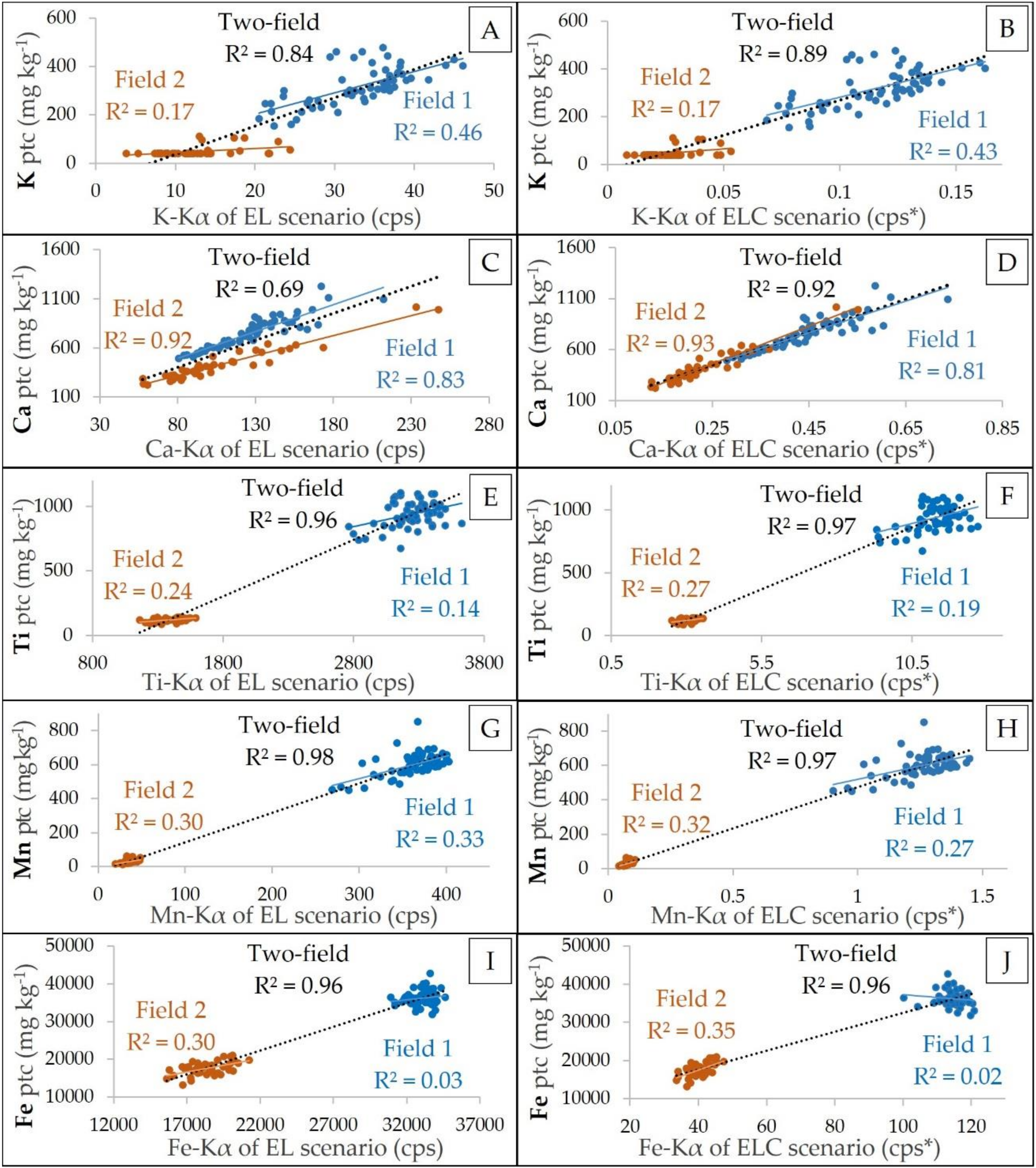
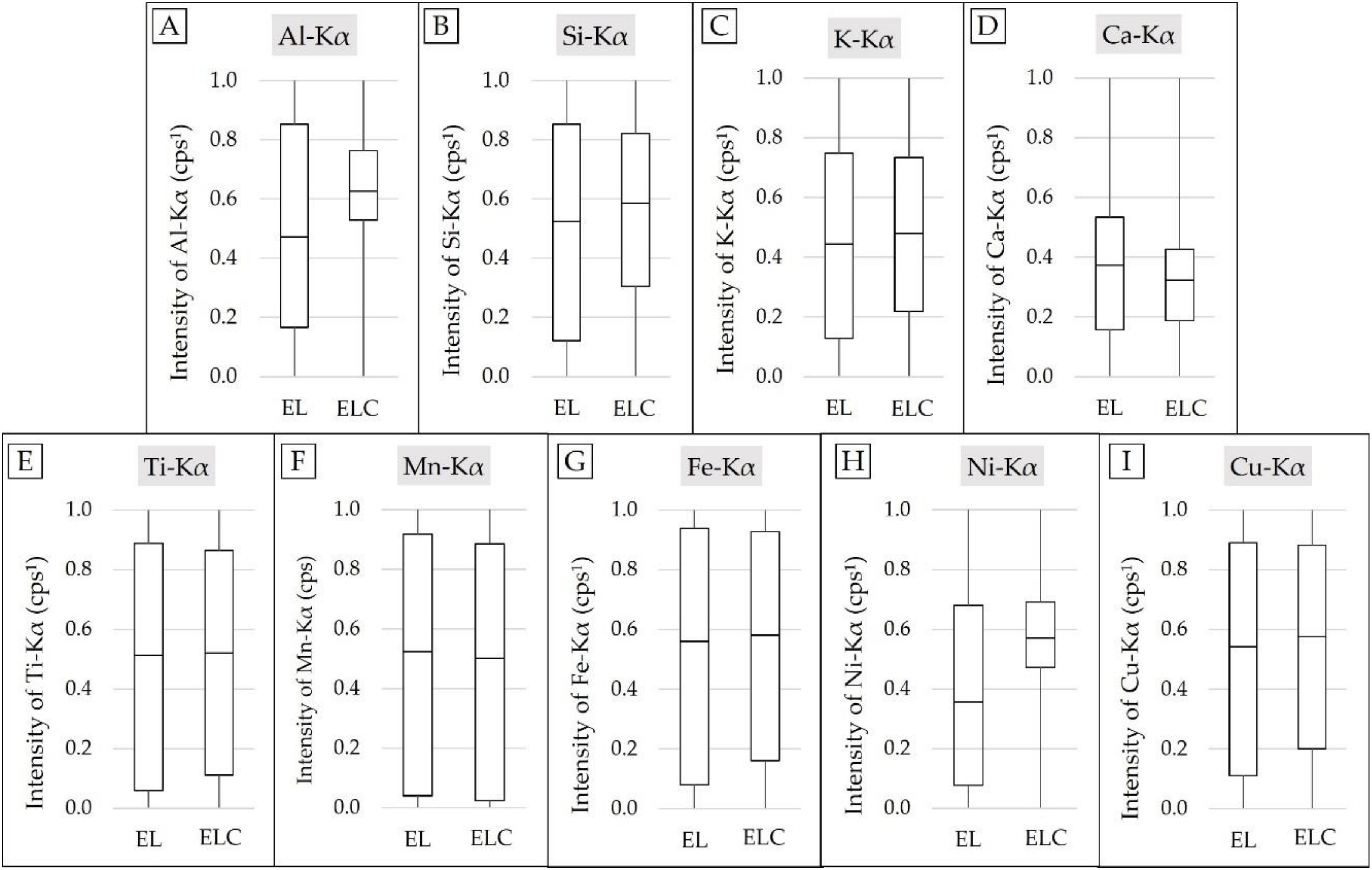
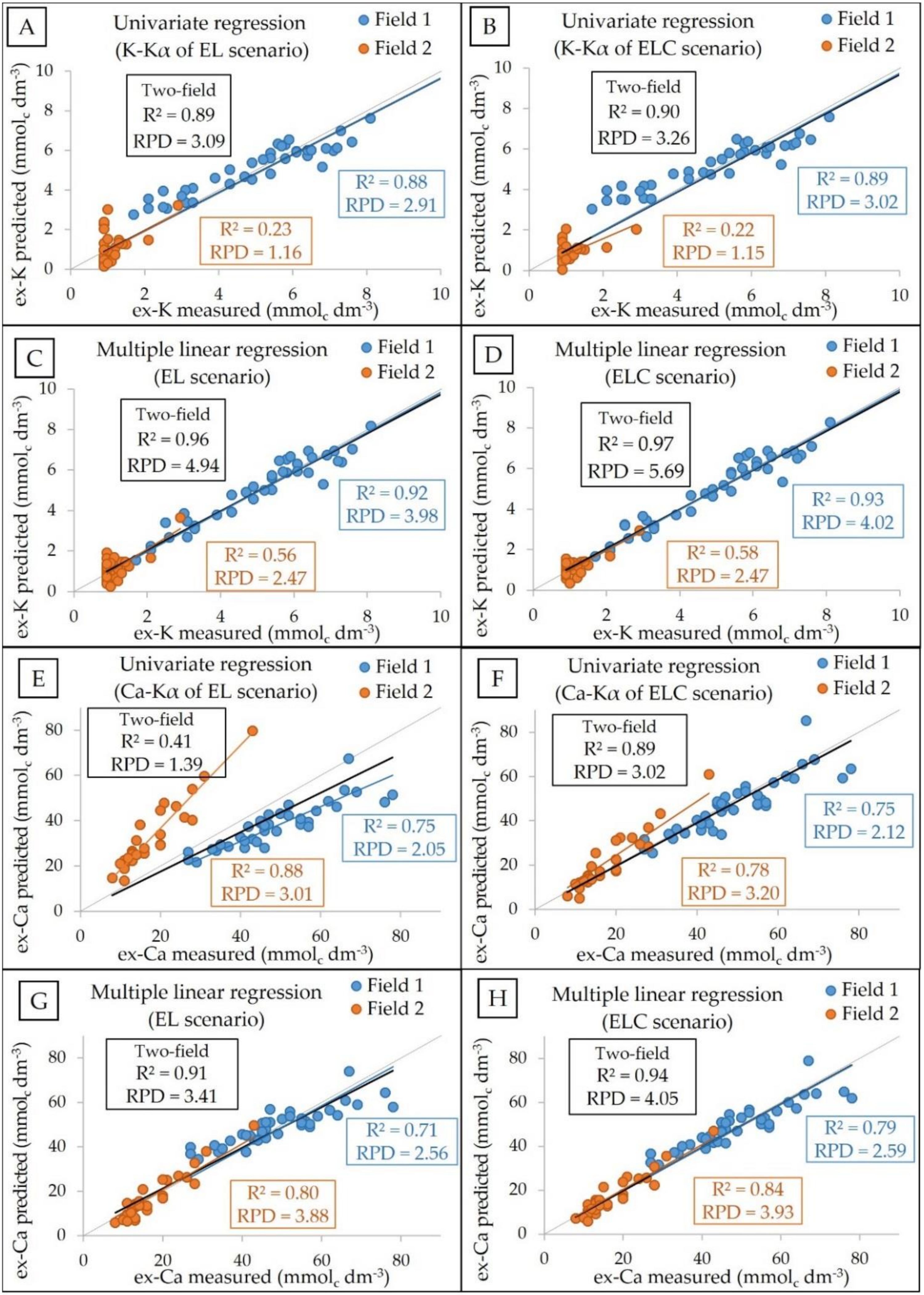
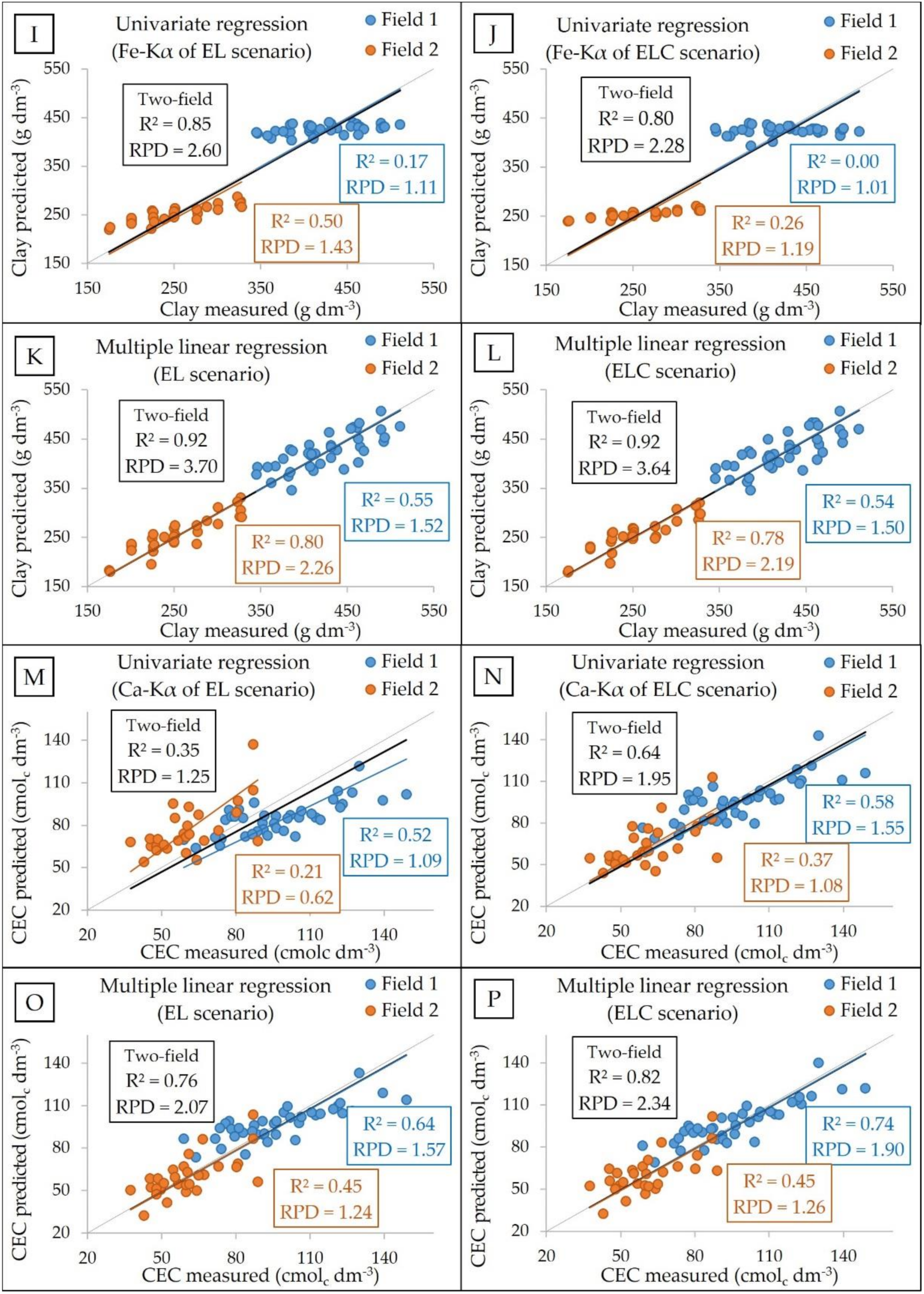
| Clay 1 | CEC 1 | ex-K 1 | ex-Ca 1 | |||||
|---|---|---|---|---|---|---|---|---|
| Cal Set | Val Set | Cal Set | Val Set | Cal Set | Val Set | Cal Set | Val Set | |
| Field 1 2 | ||||||||
| Min | 345.00 | 378.00 | 58.90 | 62.50 | 1.70 | 2.30 | 27.00 | 28.00 |
| Mean | 424.03 | 405.47 | 97.52 | 93.23 | 5.11 | 5.07 | 49.21 | 47.53 |
| Max | 511.00 | 463.00 | 148.90 | 138.40 | 10.30 | 7.90 | 78.00 | 75.00 |
| SD | 44.10 | 24.52 | 20.93 | 21.19 | 1.94 | 1.50 | 12.53 | 13.52 |
| CV (%) | 10.40 | 6.05 | 21.46 | 22.73 | 37.92 | 29.48 | 25.47 | 28.44 |
| Field 2 2 | ||||||||
| Min | 175.00 | 175.00 | 37.50 | 42.50 | 0.90 | 0.90 | 8.00 | 8.00 |
| Mean | 255.14 | 239.20 | 60.54 | 55.31 | 1.12 | 1.19 | 17.52 | 15.33 |
| Max | 328.00 | 328.00 | 88.90 | 88.90 | 2.90 | 2.30 | 43.00 | 38.00 |
| SD | 45.90 | 51.34 | 13.89 | 13.13 | 0.43 | 0.39 | 7.81 | 7.78 |
| CV (%) | 17.99 | 21.46 | 22.94 | 23.74 | 38.38 | 33.23 | 44.58 | 50.74 |
| Two-field 2 | ||||||||
| Min | 175.00 | 175.00 | 37.50 | 42.50 | 0.90 | 0.90 | 8.00 | 8.00 |
| Mean | 352.00 | 332.12 | 81.75 | 76.50 | 3.41 | 3.36 | 35.69 | 33.32 |
| Max | 511.00 | 463.00 | 148.90 | 138.40 | 10.30 | 7.90 | 78.00 | 75.00 |
| SD | 95.21 | 92.03 | 25.86 | 26.14 | 2.48 | 2.26 | 19.08 | 19.71 |
| CV (%) | 27.05 | 27.71 | 31.63 | 34.17 | 72.73 | 67.39 | 53.44 | 59.16 |
| Clay | CEC 1 | ex-K 2 | ex-Ca 2 | Clay | CEC | ex-K | ex-Ca | Clay | CEC | ex-K | ex-Ca | |
|---|---|---|---|---|---|---|---|---|---|---|---|---|
| Field 1 | Field 2 | Two-field dataset | ||||||||||
| Clay | 1.00 | −0.02 | −0.05 | 0.14 | 1.00 | 0.31 * | 0.34 * | 0.21 | 1.00 | 0.67 ** | 0.73 ** | 0.78 ** |
| CEC | 1.00 | 0.17 | 0.93 ** | 1.00 | 0.01 | 0.70 ** | 1.00 | 0.64** | 0.93 ** | |||
| ex-K | 1.00 | 0.03 | 1.00 | −0.01 | 1.00 | 0.68 ** | ||||||
| ex-Ca | 1.00 | 1.00 | 1.00 | |||||||||
| Correl 3 with ptc | 0.67 ** | 0.83 ** | 0.49 ** | 0.95 ** | 0.90 ** | 0.75 ** | ||||||
| Geo Exp. Package 3 | MLR | PLSR | ||||
|---|---|---|---|---|---|---|
| EL | ELC | EL | ELC | nLV 4 | ||
| R 2 | ||||||
| Clay | 0.92 | 0.91 | 0.92 | 0.91 | 0.89 | 4 |
| CEC 1 | 0.83 | 0.83 | 0.87 | 0.81 | 0.87 | 3 |
| ex-K 2 | 0.92 | 0.92 | 0.95 | 0.91 | 0.94 | 3 |
| ex-Ca 2 | 0.90 | 0.92 | 0.96 | 0.91 | 0.96 | 4 |
| RMSE | ||||||
| Clay | 27.44 | 31.72 | 29.40 | 32.65 | 35.56 | 4 |
| CEC | 11.90 | 11.08 | 10.19 | 11.56 | 9.42 | 3 |
| ex-K | 0.72 | 0.65 | 0.53 | 0.75 | 0.60 | 3 |
| ex-Ca | 6.09 | 5.63 | 4.09 | 5.99 | 4.11 | 4 |
| RPD | ||||||
| Clay | 3.35 | 2.90 | 3.13 | 2.82 | 2.59 | 4 |
| CEC | 2.20 | 2.36 | 2.57 | 2.26 | 2.78 | 3 |
| ex-K | 3.16 | 3.47 | 4.26 | 3.01 | 3.77 | 3 |
| ex-Ca | 3.24 | 3.50 | 4.82 | 3.29 | 4.80 | 4 |
© 2020 by the authors. Licensee MDPI, Basel, Switzerland. This article is an open access article distributed under the terms and conditions of the Creative Commons Attribution (CC BY) license (http://creativecommons.org/licenses/by/4.0/).
Share and Cite
Tavares, T.R.; Mouazen, A.M.; Alves, E.E.N.; dos Santos, F.R.; Melquiades, F.L.; Pereira de Carvalho, H.W.; Molin, J.P. Assessing Soil Key Fertility Attributes Using a Portable X-ray Fluorescence: A Simple Method to Overcome Matrix Effect. Agronomy 2020, 10, 787. https://doi.org/10.3390/agronomy10060787
Tavares TR, Mouazen AM, Alves EEN, dos Santos FR, Melquiades FL, Pereira de Carvalho HW, Molin JP. Assessing Soil Key Fertility Attributes Using a Portable X-ray Fluorescence: A Simple Method to Overcome Matrix Effect. Agronomy. 2020; 10(6):787. https://doi.org/10.3390/agronomy10060787
Chicago/Turabian StyleTavares, Tiago Rodrigues, Abdul Mounem Mouazen, Elton Eduardo Novais Alves, Felipe Rodrigues dos Santos, Fábio Luiz Melquiades, Hudson Wallace Pereira de Carvalho, and José Paulo Molin. 2020. "Assessing Soil Key Fertility Attributes Using a Portable X-ray Fluorescence: A Simple Method to Overcome Matrix Effect" Agronomy 10, no. 6: 787. https://doi.org/10.3390/agronomy10060787
APA StyleTavares, T. R., Mouazen, A. M., Alves, E. E. N., dos Santos, F. R., Melquiades, F. L., Pereira de Carvalho, H. W., & Molin, J. P. (2020). Assessing Soil Key Fertility Attributes Using a Portable X-ray Fluorescence: A Simple Method to Overcome Matrix Effect. Agronomy, 10(6), 787. https://doi.org/10.3390/agronomy10060787









